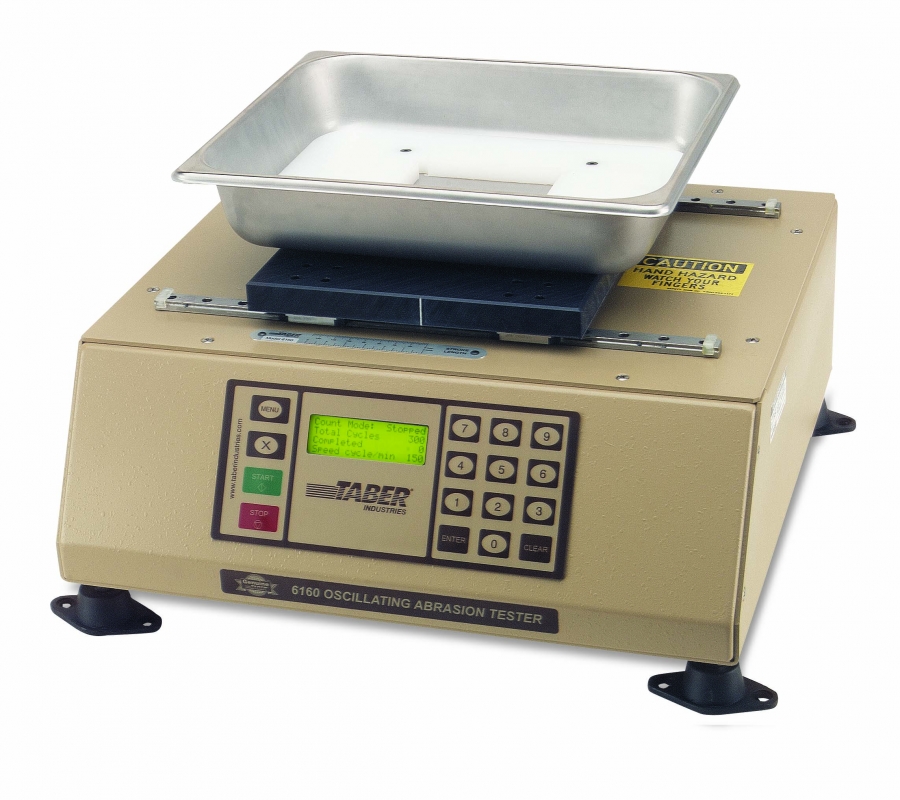Oscillating Sand Abrasion Tester 
 The TABER® Oscillating Abrasion Tester - Model 6160 is best known as an "oscillating sand tester". Described in ASTM F735 (Standard Test Method for Abrasion Resistance of Transparent Plastics and Coatings Using the Oscillating Sand Method), the oscillating sand tester is used to measure the relative abrasion resistance of a material to surface abrasion and / or marring. The primary application of the Oscillating Sand Abrasion Tester is for transparent materials and coatings utilized in windows and lenses, but it might also be used to evaluate organic paints & coatings, plastics, metals and other materials.
The TABER® Oscillating Abrasion Tester - Model 6160 is best known as an "oscillating sand tester". Described in ASTM F735 (Standard Test Method for Abrasion Resistance of Transparent Plastics and Coatings Using the Oscillating Sand Method), the oscillating sand tester is used to measure the relative abrasion resistance of a material to surface abrasion and / or marring. The primary application of the Oscillating Sand Abrasion Tester is for transparent materials and coatings utilized in windows and lenses, but it might also be used to evaluate organic paints & coatings, plastics, metals and other materials.Description
Rigid specimens that are 100mm square and less than 12.5mm in thickness are mounted in a holder located in the bottom of a sand tray so the surface is flush within 1mm. The tray is filled to a uniform depth (e.g 12.5mm) with a standardized abrasive media such as quartz silica or alumina. A scotch-yoke drive system reciprocates the tray in a back-and-forth (to-and-fro) motion which causes the entire mass of the abrasive media to shift significantly within the tray. The oscillating movement of the abrasive media results in a random pattern of scratches which simulates normal everyday wear.
Test parameters can be altered with Taber's Oscillating Sand Abrasion Tester, and allow the operator to select the operating stroke length (6.5 to 150 mm) and speed (variable from 100 - 200 cycles per minute). ASTM F735 specifies the sand tray travels a distance of 100mm at a speed of 300 strokes per minute.
In addition to the dry abrasion test, the oscillating sand abrasion tester may be used with abrasive slurry to perform erosion tests. For this application, the optional 4 inch deep tray is suggested along with a specimen tray cover. In place of the abradant, a slurry would be used (e.g. 50 - 50 mixture of solids and distilled water). The abrasivity of the slurry is dependent on the concentration of the solids in the liquid vehicle, along with the characteristics of the solid particles (shape, hardness, size, and friability).
Using a custom specimen holder (not supplied), materials of various shapes may also be tested. To generate useful data, it is important to recognize that the amount and force of abrasive media that contacts the specimen surface will change based on the curvature of the part. Specimens with a severe contour may inhibit the movement of the abrasive media during the test.
An optional kit is available to conduct the Bayer Abrasion Test on contoured lenses. This set-up involves testing a specimen against a control lens for comparative purposes.
Abradants
In December 2011, Taber Industries learned that the sole source provider of the 4/10 abradant described in section 6.1 of ASTM F735 was sold and the new company discontinued the product. The ASTM subcommittee responsible for this test method is working on initiating a round robin study to characterize / qualify a potential replacement material. The recommended material is a 6/9 Silica Abrasive Media which is available from Taber Industries. If you would like more information, please contact us.
There are a variety of standardized abradants that could be used with this instrument. Besides the silica abrasive media, other potential abradants include alumina (zirconia), silicon carbide, aluminum oxide and glass bead. For repeatable test results, the sizing and shape of the abradant is absolutely critical.
During testing, the abradant may become 'worn' as the sharp edges contact the specimen and other abrasive particles. To ensure reproducibility, new abrasive media should be used for each test. It is also recommended that the abrasive be replaced after 300 cycles for longer cycle tests.
Evaluation
Using a haze meter, the haze and light transmission of a transparent test specimen is measured and recorded. After subjecting the specimen to the specified number of abrasion cycles, the results are measured as a change in haze and light transmission. Abrasion resistance for opaque materials is measured visually or by weight loss.
Test Methods
The following link provides a listing of test methods the Taber Oscillating Sand Abrasion Tester satisfies. Please note, additional accessories may be required.
ไม่มีความคิดเห็น:
แสดงความคิดเห็น